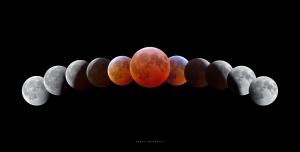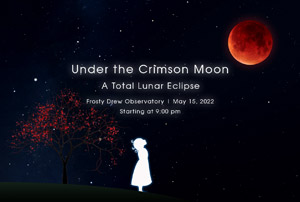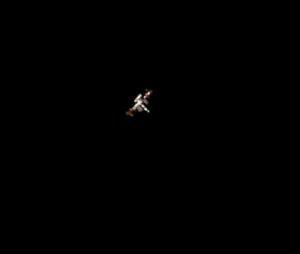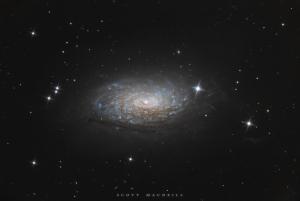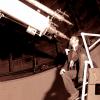Celebration of Space - May 6, 2022
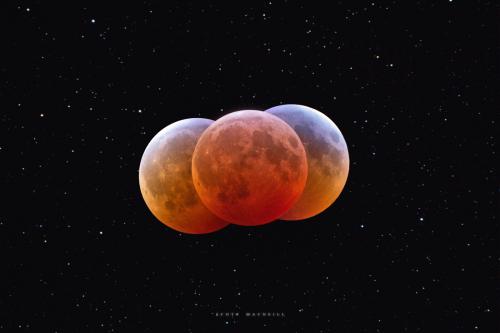
Maximum eclipse stage of the Januay 2019 Total Lunar Eclipse. Movement of the Moon in the image is due to lunar rate vs sidereal rate. Image credit: Frosty Drew Astronomy Team member, Scott MacNeill.
Starting at 9:00 pm, Sunday, May 15, 2022, and continuing overnight into the morning hours of Monday, May 16, 2022, a stunning total lunar eclipse is happening, and Frosty Drew Observatory and Science Center is ready to rock the night! A lunar eclipse happens when the Moon reaches the point in its orbit around Earth where it is on the opposite side of Earth than the Sun. We call this opposition, and is commonly referred to as the Full Moon. Though this does happen every 29.5 days (Synodic period), the Moon does not follow the same orbital path around the Sun every period. Typically, large moons, around other planets, will orbit around the equatorial region of the planet, but that is not the case with Earth’s moon. The Moon orbits Earth 5.1º inclined to the ecliptic. What that means is that the Moon follows the path the Sun takes across the sky, which is also the plane of the Solar System. Being that the Moon is 5.1º inclined to that path, sometimes the Moon will appear above or below Earth’s shadow during opposition. Though occasionally, the Moon will orbit closer to the ecliptic during opposition and end up in Earth’s shadow, either partially or totally.
During a total lunar eclipse, the Moon often casts a ruddy hue. This is due to a process in Earth’s atmosphere called Rayleigh Scattering, which scatters blue light. When sunlight enters Earth’s atmosphere it encounters all the elements that make up Earth’s atmosphere, like nitrogen, oxygen, hydrogen, carbon dioxide, etc. The light that humans see is the visible spectrum, which is made up of red, green, and blue. Red is the low energy side of the visible spectrum and has the widest gap between wavelengths. Blue is the high energy side and has the closest wavelengths. When visible light enters Earth’s atmosphere, molecules and atoms in the air will polarize and scatter blue light, this is why the sky is blue. Though during a total lunar eclipse, the same process will largely filter out all blue light, leaving only red and green light to continue onward towards the Moon. Yes, the Moon is in Earth’s shadow, but sunlight will refract as it enters Earth’s atmosphere, and again when it leaves, which will cast a little bit of light onto the Moon. If there are larger particulates in Earth’s atmosphere like ash from volcanic eruptions, smoke from wildfires, or even smog, these particles will create a process called Mie Scattering, which is where these particles cannot fit between the blue (and sometimes green) wavelengths, causing those colors to scatter. This is what makes a hazy day, and also why the Moon is very red when viewed in wildfire smoke. If this happens then only the red light makes it to the Moon, leaving the Moon a very deep crimson red.
Frosty Drew Observatory and Science Center will be open for the entire eclipse event, weather permitting. We will have telescopes set up on the Moon as well as live views of the eclipse on screens around the campus. In the Sky Theatre we will show a feature of previous lunar eclipses photographed at Frosty Drew Observatory. Additionally, we will host a live stream of the eclipse on our YouTube channel, which will feature the eclipse live from a telescope set up on the Frosty Drew campus. Check out our event page for the lunar eclipse. Then stop in on our YouTube channel, bookmark our eclipse event, and catch up on some other videos produced by Frosty Drew Observatory and Science Center.
After a few weeks of little-to-no notable evening satellite activity, China’s space station – Tiangong, is returning to the evening sky with several fabulous passes in store for U.S. sky watchers. Due to the stations orbiting earth generally inclined about 50º to the equator, we do get passes everyday, but not all passes will happen during the rather smallish window of viewing opportunity. Which is when the Earth-bound observer is in night, but the station is still in direct sunlight. As we approach the Summer Solstice, this window of opportunity becomes much wider, producing a significantly higher number of visible passes overnight. We are only listing passes this week for Tiangong, but starting on Friday, May 13th, we will begin listing passes of the International Space Station as well. In the meantime, here are several notable passes of Tiangong for this weekend and the coming week:
Fri, May 6 at 9:05 pm, starting in SW, rising to 45º, heading towards the ESE and into orbital sunset
Sat, May 7 at 10:42 pm, starting in the W, rising to 83º and into orbital sunset ← Awesome pass!
Sun, May 8 at 8:42 pm, starting in the WSW, rising to 65º, heading towards the E. ← Awesome pass!
Mon, May 9 at 9:20 pm, starting in the W, rising to 87º, heading towards the E, and into orbital sunset ← Totally awesome pass!
Tue, May 10 at 9:57 pm, starting in the W, rising to 84º, heading towards the E ← Awesome pass!
Wed, May 11 at 8:57 pm, starting in the W, rising to 87º, heading towards the E, and into orbital sunset ← Awesome pass!
Thu, May 12 at 9:34 pm, starting in the W, rising to 63º, and into orbital sunset ← Awesome pass!
Check out that list! So many amazing passes are coming up this week. Note that these times are applicable to Southern New England, and generally usable for the entire Northeast. You will notice that some of these times are much later than usual. That is because sunset is setting quite late as we close in on the Summer Solstice. Though in the weeks around the Solstice, we will start seeing passes of the stations for every orbit over the entire night. Now put these times on your calendar and set your alarms to catch a sight of how amazing humanity can be when we try!
Over the past week the New Moon occurred, which is the best time to be out under the stars at Frosty Drew Observatory. The Moon is awesome, and one of the reasons that life exists on Earth, though the Moon is certainly the center of attention when it is up, and will outshine most other dim objects in the night sky. Once the Moon departs, at Frosty Drew, our astronomy team waits for clear nights. On these nights we direct the new 24 inch PlaneWave telescope to the sky and capture fantastic images of the Universe.
This past week, we spent a considerable amount of time capturing a view of the Messier 63 (M63) galaxy, commonly referred to as the Sunflower Galaxy. Messier 63 has a rather strange galactic classification, known as a flocculent spiral galaxy. At first glance, a flocculent spiral, like M63, will appear to have many arms, when in reality it only has two arms. Each arm is littered with star formation, and intense dust lanes. The driver of star formation in these types of galaxies is relatively unknown. M63 resides at 27 million light years distant, and spans a diameter of over 98,000 light years. Check out our recent image of Messier 63.
Over the past couple of years, the Frosty Drew Astronomy Team has been working on a new project, called the Messier Re-imaging Project (or Project Messier). The goal of this project is to re-image all 110 deep sky objects that make up the famous Messier Catalog of deep sky objects. We are well into completing this project, with a good portion of the catalog already imaged. Part of this project will be a new exhibit in the Frosty Drew Science Center, that will show the results of our work, which is what the renovations of late were related to. Also, there will be a new section on our website dedicated to showcasing the results of this project. These new pages were released this past week. This page will list all Messier objects, but the objects that we have published will be shown in high resolution vs the smaller images that we have shown previously, and are still showing for objects we have not released yet. Take a moment to browse the gallery, and check back in regularly as we are always adding additional images. Enjoy!
- Author:
- Scott MacNeill
- Entry Date:
- May 6, 2022
- Published Under:
- Scott MacNeill's Columns

